Learning from history: Where are the 1,200 crypto projects that raised seed funding 2 years ago now?
Author: Lattice Fund
Compiled by: Xiaobai Navigation Coderworld

introduce
Last year, we published our 2021 Seed Stage Review to provide a clear picture of trends in the seed stage that year. How many companies shipped to mainnet? How many found product-market fit? Who launched?Token?
With the 2024 report, we now turn our focus to 2022 to better understandcryptocurrency在种子阶段的进展和趋势。该报告分析了 2022 年以来超过 1,200 个公开的加密货币预种子轮和种子轮,提供了对全行业、特定部门和生态系统层面趋势的见解。与我们之前的报告一样,我们正在开源我们的数据库,以便进一步探索和分析。我们邀请您提供反馈并欢迎任何更正;请随时通过 hi@lattice.fund 与我们联系。
Executive Summary
2022 届的项目们在加密货币历史上最繁荣的时期之一获得了资金。今年宣布融资的团队可能受益于 2021 年和 2022 年初的牛市。考虑到市场的泡沫,我们预计与熊市期间融资的团队相比,这些指标可能会出现负面影响。我们的分析证实了这些预期,但也有积极的收获。
Nearly 1,200 companies have received a total of $5 billion in investment since 2022, a 2.5-fold increase from the previous year. Here are the main highlights:
Breakthrough in 2022
-
Any year has its share of big success stories, and 2022 is no exception.
-
In terms of infrastructure, we see the re-staking protocol Eigenlayer,walletAs-a-service provider Privy and parallel EVM Sei have both raised seed rounds. It’s worth noting that each of these teams helped kick-start a broader narrative.
-
In the DeFi space, the breakout stories of 2022 are Perp Dex like Vertex and Apex and professional NFTs exchange Blur.
-
Gaming was the leading consumer segment with nearly $700 million invested. Despite the large amounts of money invested, the two biggest success stories raised relatively small amounts of money. Pixels and PlayEmber each raised less than $3 million in seed rounds.
Launching in a Challenging Market
-
Despite the bear market, nearly three-quarters of projects have successfully launched products on the mainnet. Product-market fit (PMF) and follow-on financing have become more challenging compared to 2021, with both falling significantly year-on-year.
-
18% of groups have closed or stopped development, up from 13% in 2021.
-
Only 12% teams received follow-up venture capital, a significant drop from 50% in 2021.
-
只有 15% 的项目推出了代币,低于 2021 年的 50%。
Renewed focus on infrastructure and CeFi
-
After a detour in 2021, investors returned to more proven and consistent areas such as infrastructure and CeFi, pouring nearly $2 billion and nearly $450 million into these sectors, respectively, a 3x and 2x increase over 2021 figures.
-
80% of CeFi projects and 78% of infrastructure projects have been launched on the mainnet, reflecting investors' strong confidence in these areas.
-
The results at the application layer are more complex, with 66%'s consumer Web3 products and 68%'s DeFi team delivering products to the mainnet.
-
Consumer teams were more likely to cease operations, shutting down at nearly twice the rate of infrastructure teams.
-
Payment (86%) andwalletThe (90%) project is most likely to be launched on the mainnet.
Ethereum leads, Bitcoin continues
-
Ethereum remains the dominant layer-one ecosystem in terms of fundraising, while Bitcoin projects continue to demonstrate resilience.
-
$1.4 billion was invested in Ethereum-based projects, followed by nearly $350 million in Solana-based projects.
-
Fundraising in the Polkadot ecosystem has dropped significantly, down 40% year-on-year.
-
Teams building on Solana and Ethereum are also likely to receive follow-on funding.
-
In contrast, no team in the NEAR ecosystem has been able to raise follow-on funding.
-
BinanceProjects in the ecosystem are least likely to remain active, with a third of teams ceasing operations. Solana’s failure rate also doubled from 2021 to 26%.
-
The Bitcoin project continues to exist, and the team at 100% is still active two years later.
Methodology
The report is based on a combination of first-party data, supplemented by insights from Messari, Root Data, Crunchbase, and other sources. To assess the progress of the seed-stage market, we categorized each company by stage, including "active but not delivering" and "no longer active," with additional breakdowns by ecosystem and industry. While we have made every effort to ensure data accuracy, we acknowledge that errors may occur due to reliance on third-party data. Among ecosystems, we only included in the chart those with more than 15 teams that were able to raise a first round of financing.
One of the most challenging aspects of this analysis is determining whether a project has achieved product-market fit (PMF). Unlike the objective milestone of "product delivery," PMF is often subjective and can be fleeting, especially in the rapidly changing crypto market. We combine on-chain data from analytics providers such as Dune Analytics and DeFiLlama with information from company websites and blogs to make these determinations.

(注:Lattice 的配图,将从左到右将被分析的产品分为活跃但未交付、产品交付、有PMF、有代币、不再活跃、被收购和关停等几个阶段)
Seed round project status
Our seed-stage review began as an internal analysis to identify projects that were gaining traction but had not yet raised follow-on funding, which could be targets for the Lattice Fund. However, it turned out that the data was interesting enough to share with the wider industry.
This research is valuable because it reveals the health of individual sectors, ecosystems, and the broader early-stage market over time. Given that most seed-stage teams raise funds to sustain operations for approximately two years, we decided to use that time frame to review the seed years.
In 2022, over 1,200 crypto companies raised over $5 billion in seed and pre-seed funding. Looking back at this group, 72% of companies have launched on mainnet or equivalent networks, up from 66% last year. Meanwhile, 18% of projects either failed to deliver or have shut down, which is consistent with last year's data. However, the most notable drop was in teams looking for PMF, which fell to nearly 1.5%. It's worth pointing out again that it's difficult to assess how much traction projects actually have when they run off-chain, so we may be missing some teams with early PMF.
During the bear market, attracting users became increasingly difficult as retail interest waned. Hot sectors in 2022, such as NFTs, the metaverse, and gaming, are not attracting users as they did two years ago. In contrast, infrastructure projects that primarily serve other cryptocurrency companies have proven to be more resilient. The best example is Eigenlayer, which announced a seed round in January 2022 and successfully expanded its AVS listing strategy, with middleware projects eager to collaborate.
This is a good reminder.Today’s hot sectors don’t always appear in tandem with investor interest. For example,Metaverse75 teams in the field raised nearly $280 million, but not a single team found PMF,overtake
The 21% team has been closed, and you rarely hear anyone talking about it.Metaverse. With DePIN or Ai In comparison, they barely registered in 2022, but are two of the hottest topics today.
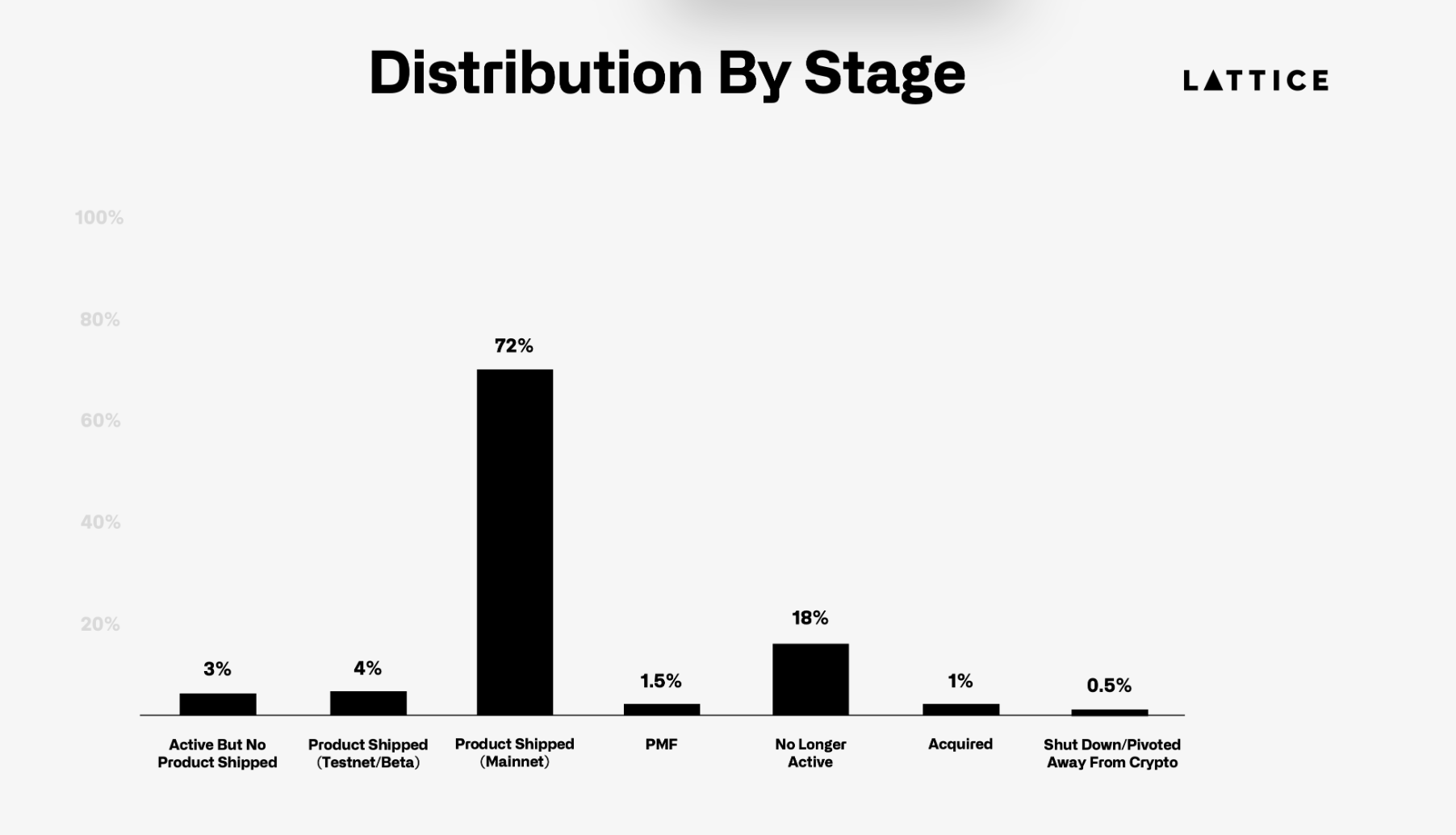
(The data chart shows that the seed round financing project of 72% in 2022 already has a mainnet)
风投捂紧钱包
Teams in 2022 raised funds during one of the most prosperous periods in crypto history. Teams that announced raises in 2022 likely did so before the Terra and FTX crashes, which sent markets into a deep freeze. While overall funding was up 92% from 2021, follow-on markets tell a different story. Only 12% of the 2022 teams were able to raise more than they did in the past two years. This is in stark contrast to teams in 2021, when nearly a third of teams received follow-on funding.
Interestingly, the number of token issuances has also been declining year by year, withXiaobai NavigationOnly 15% teams in the cohort launched tokens, compared to 50% in 2021. This significant drop can be attributed to two main factors: 1) The 2022 cohort likely missed the bull run window, with many teams scrambling to launch products in the first half of 2024 before launches dried up over the summer. 2) Due to the decline in DeFi liquidity, decentralizedexchange Decentralized Exchange (DEX) launches have fallen out of favor and token issuance has shifted to centralized exchanges (CEX). CEXs now charge high listing fees, often reaching seven figures, and demand a large percentage of the token supply. The saturation of the token market, combined with the selectivity of CEXs and the diminishing appeal of DEX launches, makes it more challenging to bring tokens to market.
Fly to Infrastructure
Infrastructure investment tripled compared to 2021, reflecting a clear shift in investor focus. While interest in infrastructure appears to wane at the end of 2024, it is the most favored sector throughout 2022 and 2023. In contrast, DeFi was the only sector to see a year-over-year decline in investment, likely due to the consequences of DeFi’s rapid fallout in the summer of 2020.make moneySchemes and Ponzi economics proliferated.
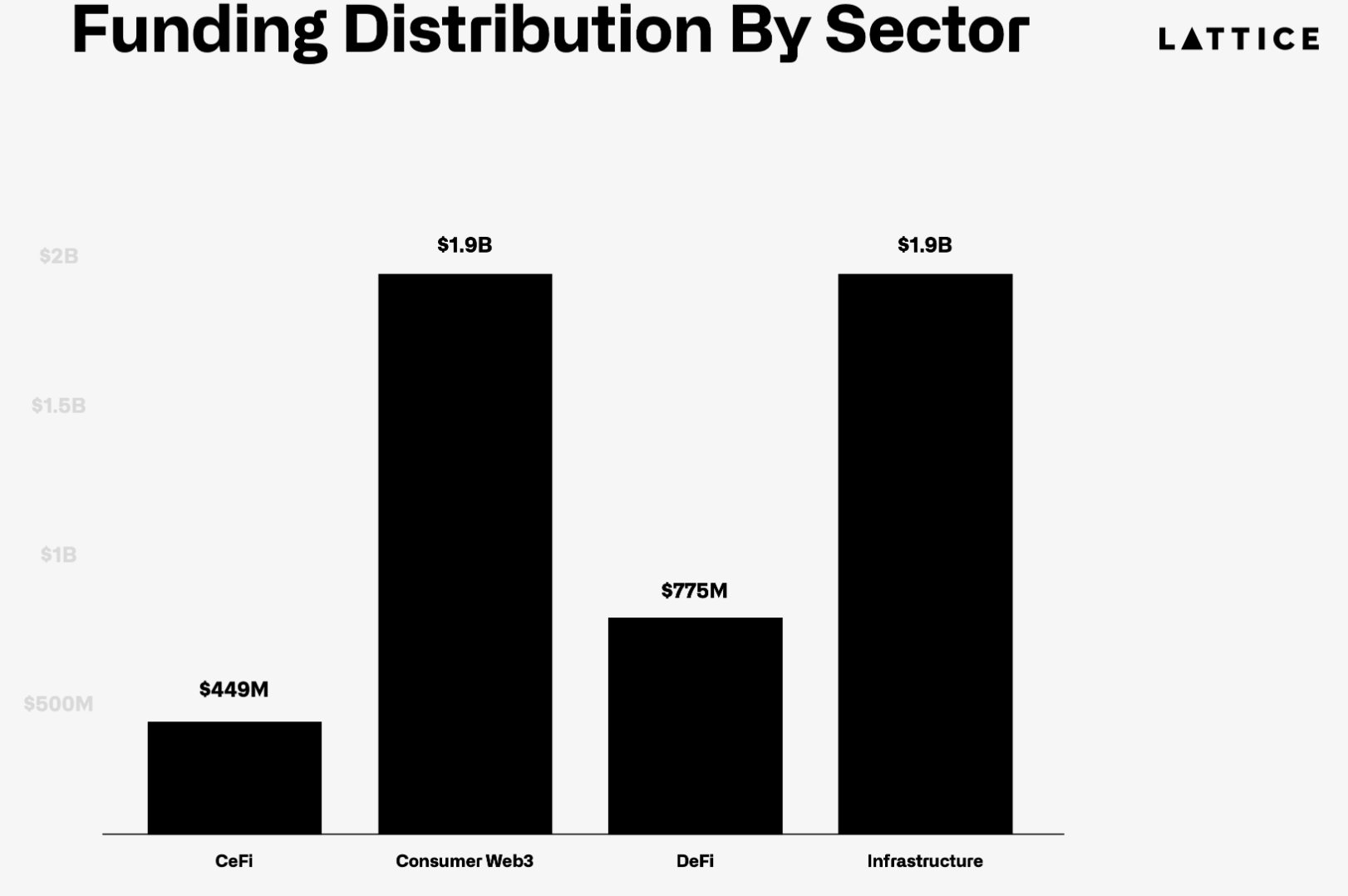
Investors are rewarded for following infrastructure trends, and these teams are most likely to raise follow-on funding and launch on mainnet. Conversely, DeFi and consumer teams are more likely to launch tokens, but also more likely to shut down. The application layer is feeling the pinch - without additional funding, teams are forced to either launch tokens or shut themselves down.
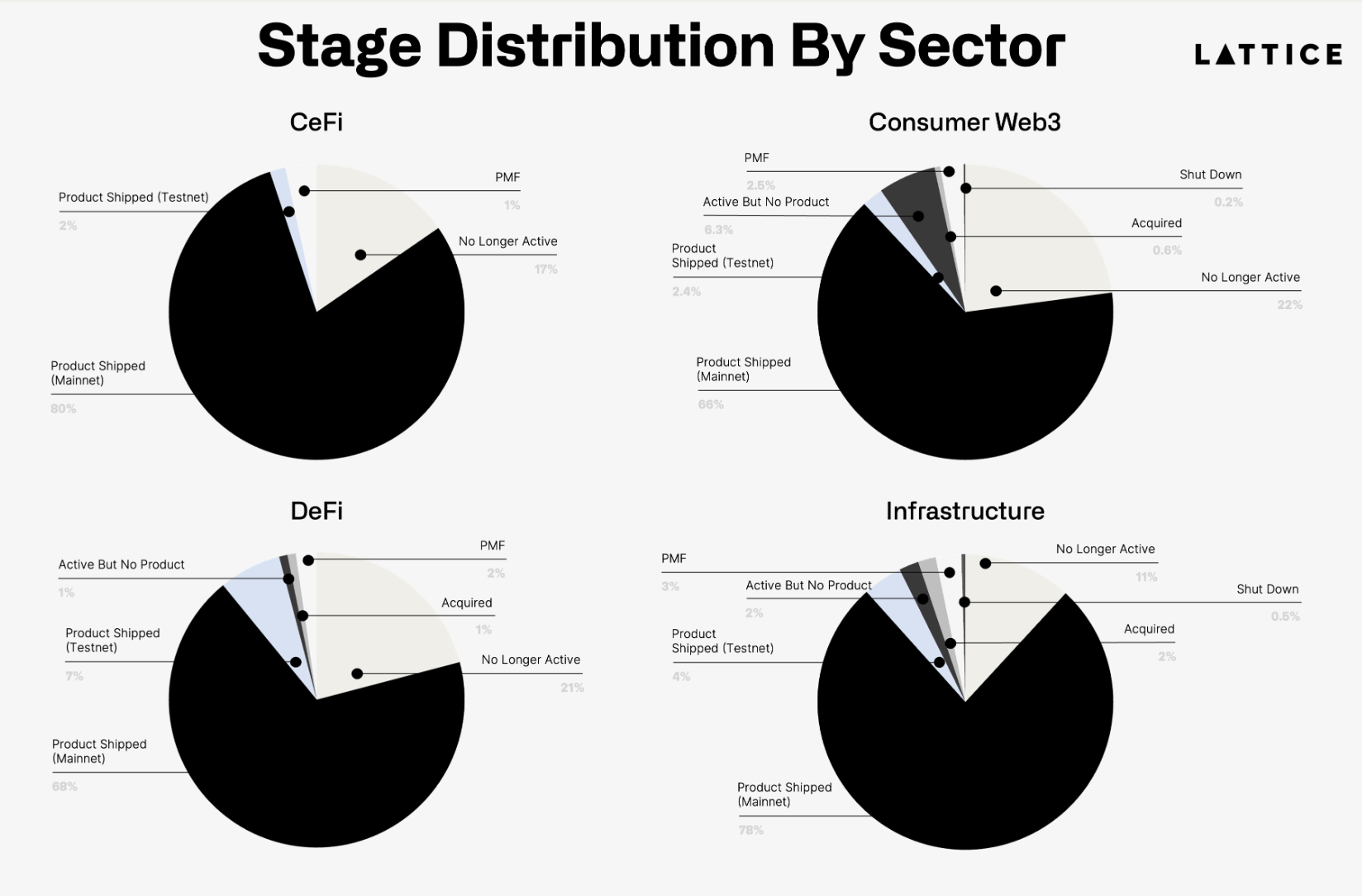
(The pie chart shows that seed round financing projects in various tracks have basically delivered more than 70% to the main network (black part); but most of them have not found PMF)
Not all ecosystems are created equal
Development across the ecosystem reveals significant differences in project success rates. Nearly 801 TP3T of Ethereum-based projects have shipped products, outperforming Solana, which has only 611 TP3T shipped, down from 751 TP3T in 2021. While Solana has clearly weathered the bear market well, the massive influx of capital at the end of 2021 may have led to excess funding.
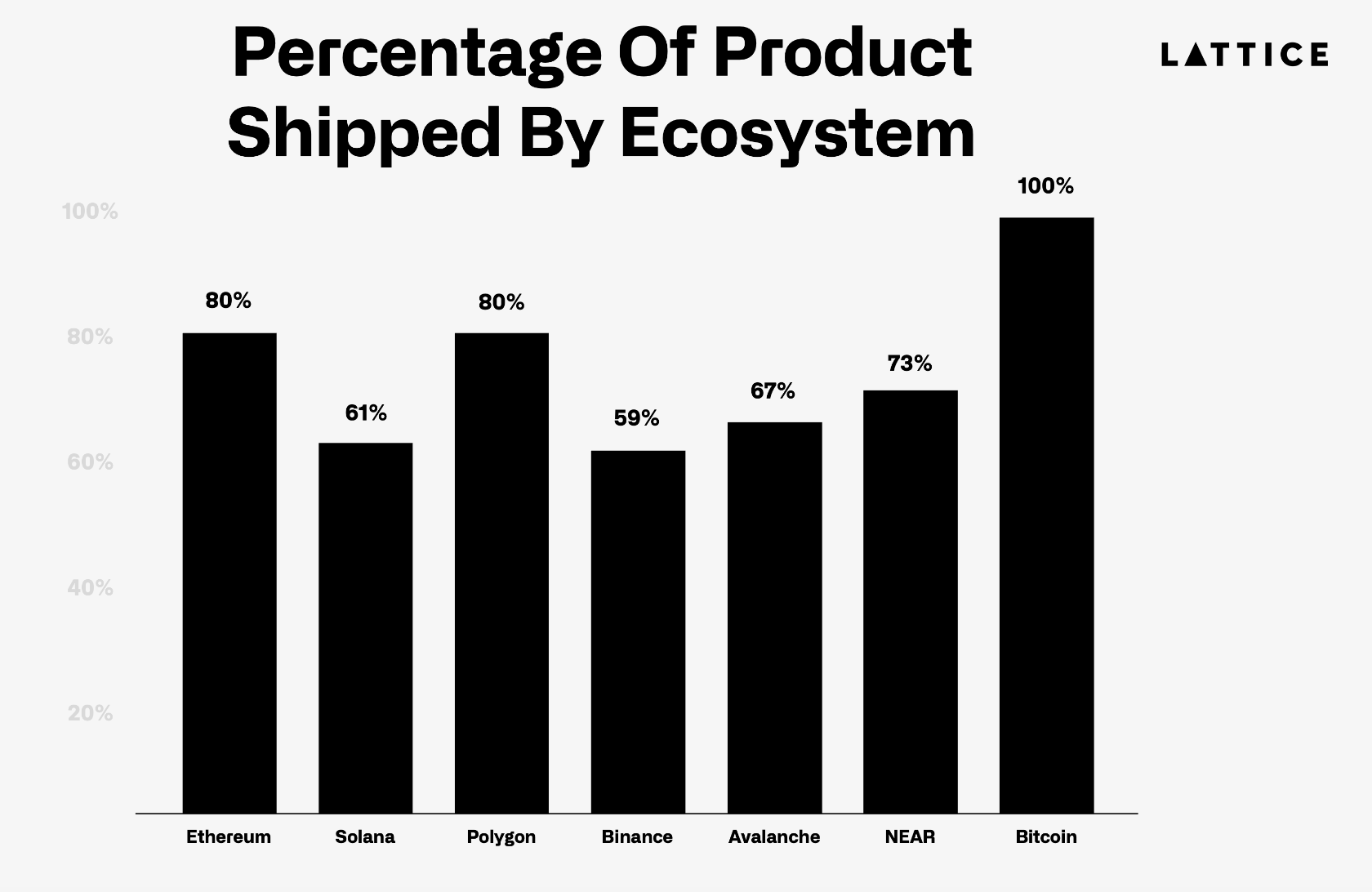
2022 年种子阶段团队的失败率与 2021 年团队保持一致,但各个生态系统内出现了显着差异。正如去年所观察到的,币安生态系统内的团队最容易关闭,现在 Avalanche 生态系统中的团队也加入了这一行列。值得注意的是,基于 Solana 的项目的失败率翻了一番,超过 25% 的团队停止运营。这一增长可能是由于牛市期间投机资本的涌入,导致 FTX 后 Solana 面临的特别具有挑战性的时期出现过度扩张和随后的损耗。然而,很明显,熬过这一困难阶段的团队已经得到了回报。此外,值得强调的是比特币生态系统团队的弹性,他们不仅继续交付,而且表现出非凡的持久性,反映了比特币网络本身的可靠性。
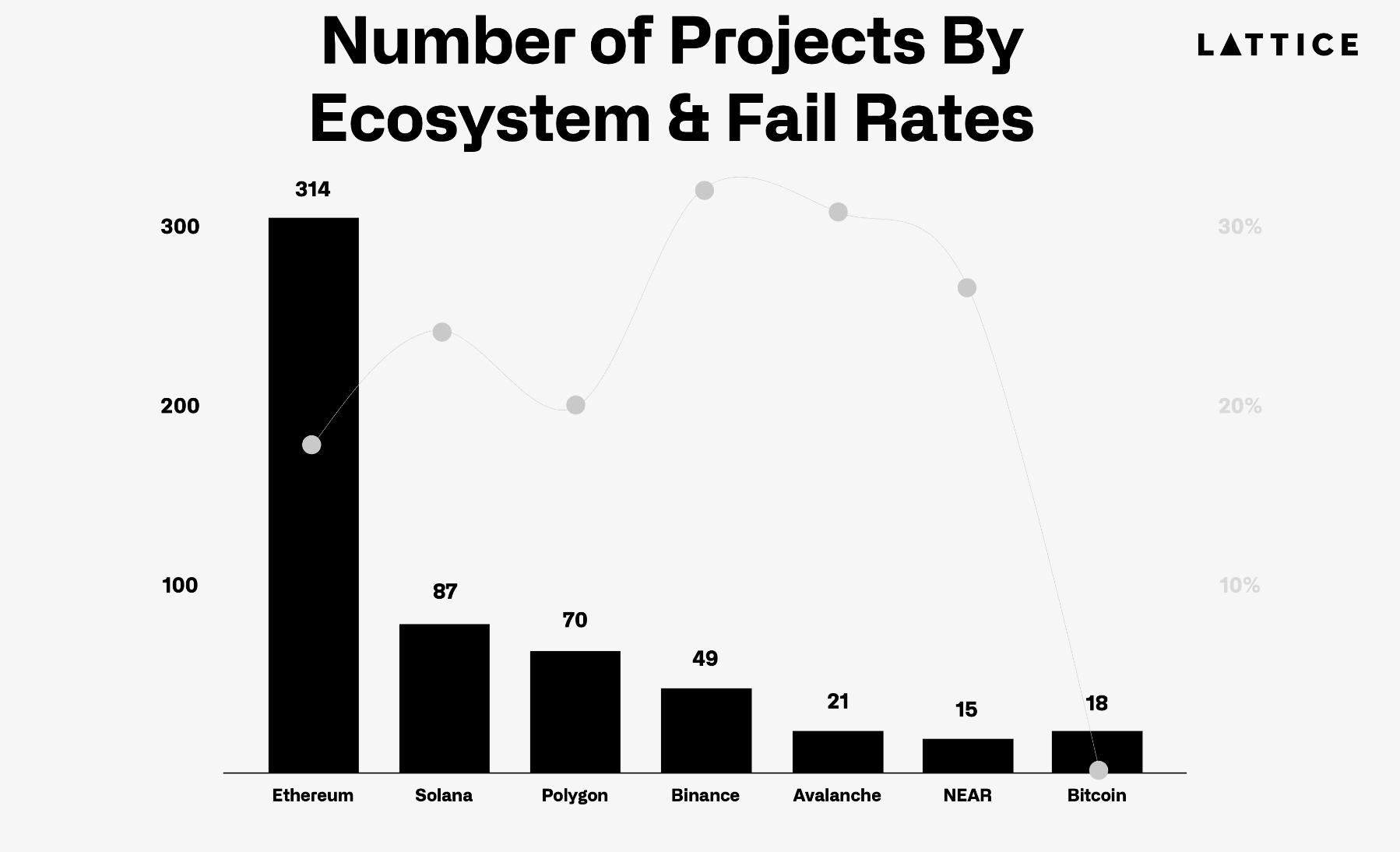
The 2022 follow-on funding landscape reveals significant declines across all major ecosystems. Only 13% of Ethereum-based projects were able to secure additional funding, down from 31% in 2021. Similarly, only 13% of Solana startups raised follow-on funding, a significant drop from 30% last year. Notably, ecosystems such as Flow, StarkNet, and NEAR struggled to attract additional investment, with none of their projects receiving follow-on funding, highlighting the challenges these platforms face in maintaining developer and investor interest. This is particularly interesting given the amount of funding that entered the base layer of each ecosystem in late 2021 and 2022, with Dapper Labs raising nearly $600 million in 2021, NEAR raising $500 million in 2022, and Starkware raising nearly $200 million in 2021 and 2022.
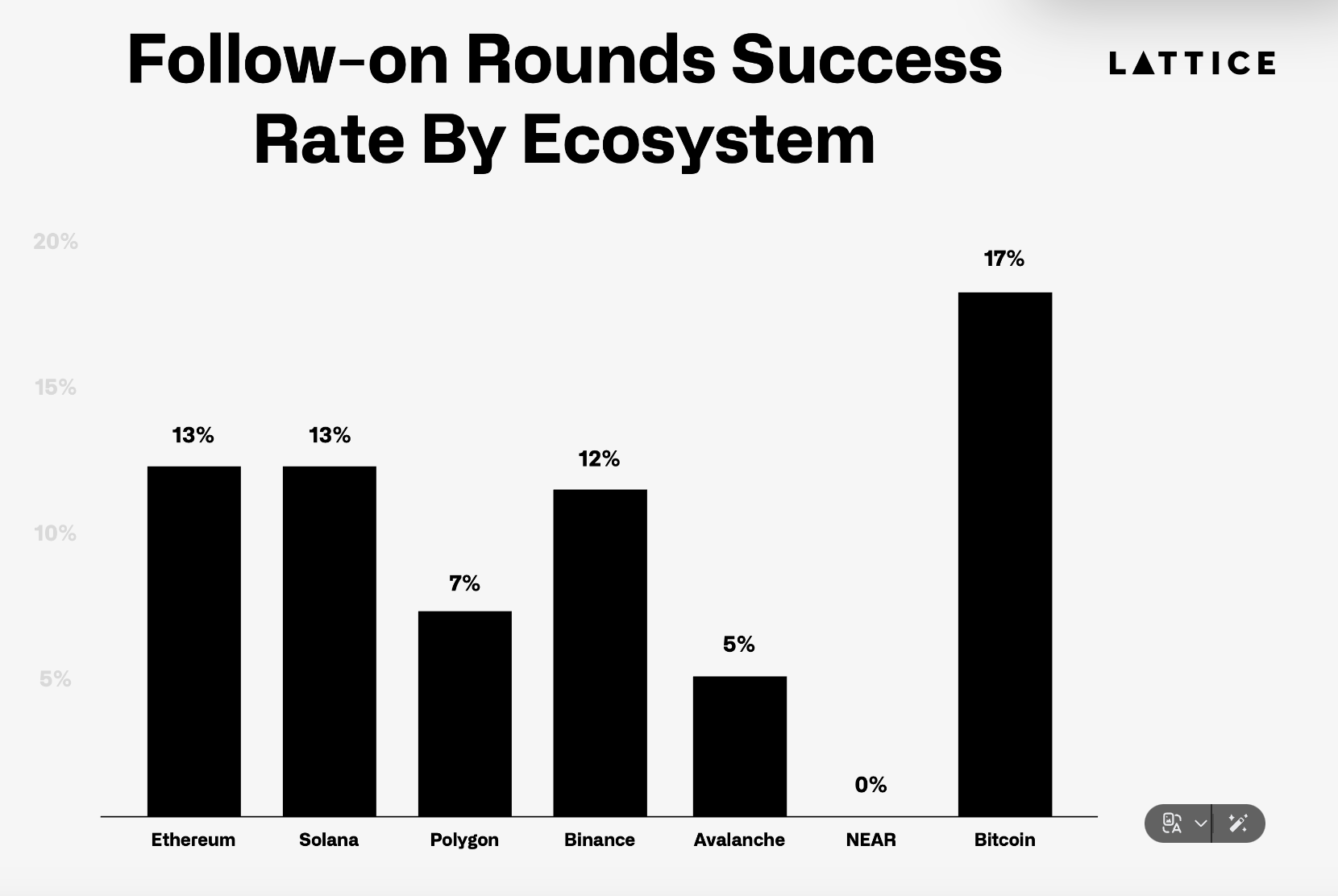
What happens next
The situation in 2022 is more challenging than in 2021. Finding PMF in a sideways market without a lot of new retail net participation remains a challenge. Some teams have pivoted to hot industries with retail participation today (such as gambling-related applications). In addition, the significant reduction in teams receiving follow-on funding will limit the time these teams have to pivot to new things. Finally, the significant increase in seed-stage startups and the tightening of the token issuance market means more teams are trying to pass a narrower token issuance opportunity.
Compounding all of these issues is the fact that investors have been moving into today’s hotter sectors (e.g. DePIN and Ai) and ecosystems (e.g. Base and Monad).This highlights that the rewards come not from chasing what’s hot now, but from what will be hot 1-2 years from now.
We have no doubt that the crypto seed-stage market will remain healthy, with active participation from nearly every fund, including a16z’s newly launched Crypto Startup School. For this group of teams looking to raise Series A and beyond, the robustness of the late-stage market remains a question. Even within our own portfolio, we’re seeing a shift in the narrative impacting founders’ ability to raise capital.
Industries and trends worth watching
Privacy-supporting apps
Recently, there has been an increase in investment in privacy-enhancing technologies, and two privacy infrastructure trends have emerged in the past year: zero-knowledge transport layersSafety (ZK TLS) and fully homomorphic encryption (FHE). ZK TLS is currently theSafetyZK TLS projects like Opacity are working with companies like Lattice portfolio company NOSH to enable Nosh to leverage existing web2 delivery markets. In this example, a driver logs in with their Doordash credentials in the nosh driver app, which the protocol treats as proof of identity. When the demand side of the network matures, drivers can make deliveries for Doordash in the nosh driver app, and earn tokens if the order comes from the protocol network (not Doordash). We expect many more use cases to emerge for this new privacy primitive.
Similar to ZK TLS, advances in FHE infrastructure could enable a new class of cryptographic applications, from private DeFi to DePINfied data collection. An early practical example of this technology is sharing sensitive health information with AI companies. Lattice protfolio company Pulse is using the DePIN flywheel to collect health data, which can be monetized by allowing researchers to analyze encrypted genetic data to identify patterns or biomarkers without access to the original genetic information, thus maintaining confidentiality. As privacy infrastructure advances and converges with broader trends — namely AI agents and decentralized physical infrastructure networks (DePIN) for data collection — it could unlock a new wave of consumer and enterprise-focused applications.
Augmented reality applications and infrastructure
Broader technology trends heavily influence where cryptocurrency founders’ efforts are directed and where investor funds flow. We’ve seen this firsthand with the surge in AI-related startups in 2023-2024 following OpenAi’s massive AI improvements. With Apple, Meta, and Snap all launching significant strategies in the AR space, we expect to see more and more crypto startups emerge in the space as AR-related technologies finally reach the masses. One example from the Lattice portfolio is Meshmap, which is building a decentralized 3D map of the world. As the installed base of AR devices is set to explode in the coming years, it will be critical for app developers to build 3D maps of their experiences. It may be premature to get excited about the metaverse in 2021, but the lesson from last year’s and this year’s reports is that what people aren’t focusing on is where Alpha can be generated.
BlockchainSupported collectibles markets
Collectibles trading is mostly related to digital asset trading (especially NFT), butBlockchainSupported collectibles markets are emerging, from spirits marketplaces like BAXUS to watches through platforms like watch.io and Kettle. Collectibles trading is already a large off-chain market, but suffers from a lack of instant settlement, physical custody, and reliable authentication.
We believe these challenges areBlockchainThe opportunity is provided by the Blockchain-Based Collectibles Market (BECM), which is specifically designed to meet the needs of collectibles traders. BECM enables instant transactions through cash settlement, significantly reduces settlement time from weeks to seconds through the use of stablecoins, and adopts NFTs to represent physical assets held by trusted custodians. This model can unify fragmented markets, enhance liquidity, eliminate individual storage burdens, and establish trust through identity verification. BECM also supports financial innovations such as borrowing against collectibles, making the act of collecting more financially dynamic. With these improved efficiencies, BECM has the potential to significantly expand the total addressable market for collectibles by bringing in more traders, liquidity, and inventory.
Ecosystem rotation
Our tables and charts only include ecosystems with more than 15 projects raising venture funding, the smallest numbers were close to 15 projects and were therefore just excluded. Perhaps unsurprisingly, we expect significant changes in the ecosystem, and given the trends we’ve seen, Polkadot, NEAR, and Avalanche will be L2 ecosystem, and emerging L1 and 2 ecosystems such as Monad, Berachain, and MegaETH.
The article comes from the Internet:Learning from history: Where are the 1,200 crypto projects that raised seed funding 2 years ago now?
大多数代币在上市后24小时内经历显著价格上涨,通常在第二天开始回调。 作者:Simplicity Group 编译:小白导航 coderworld 最近,Binance 针对 Meme 上线不同现货与合约产品的事件备受争议。 上币,上到关键CEX,是很多人持币…